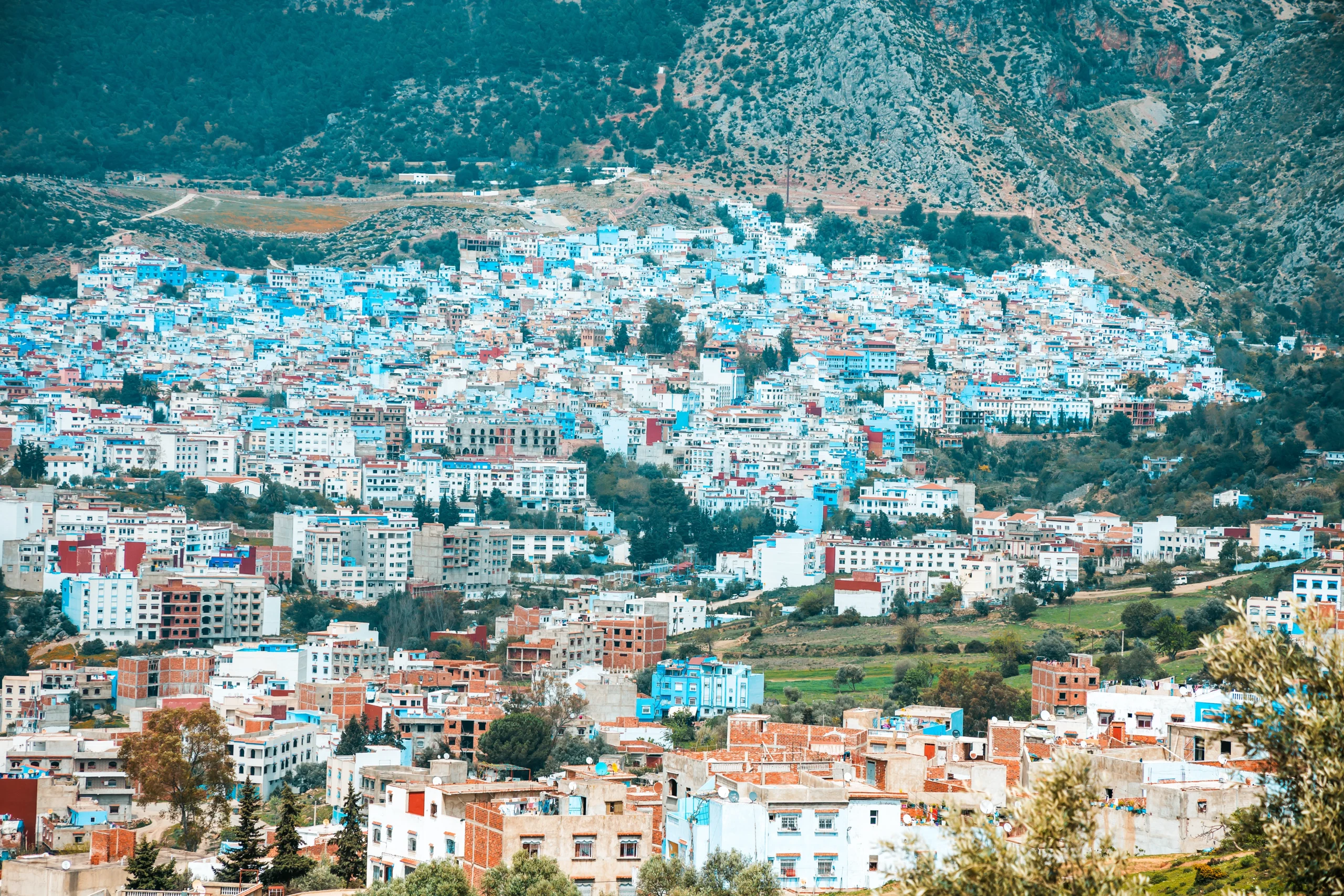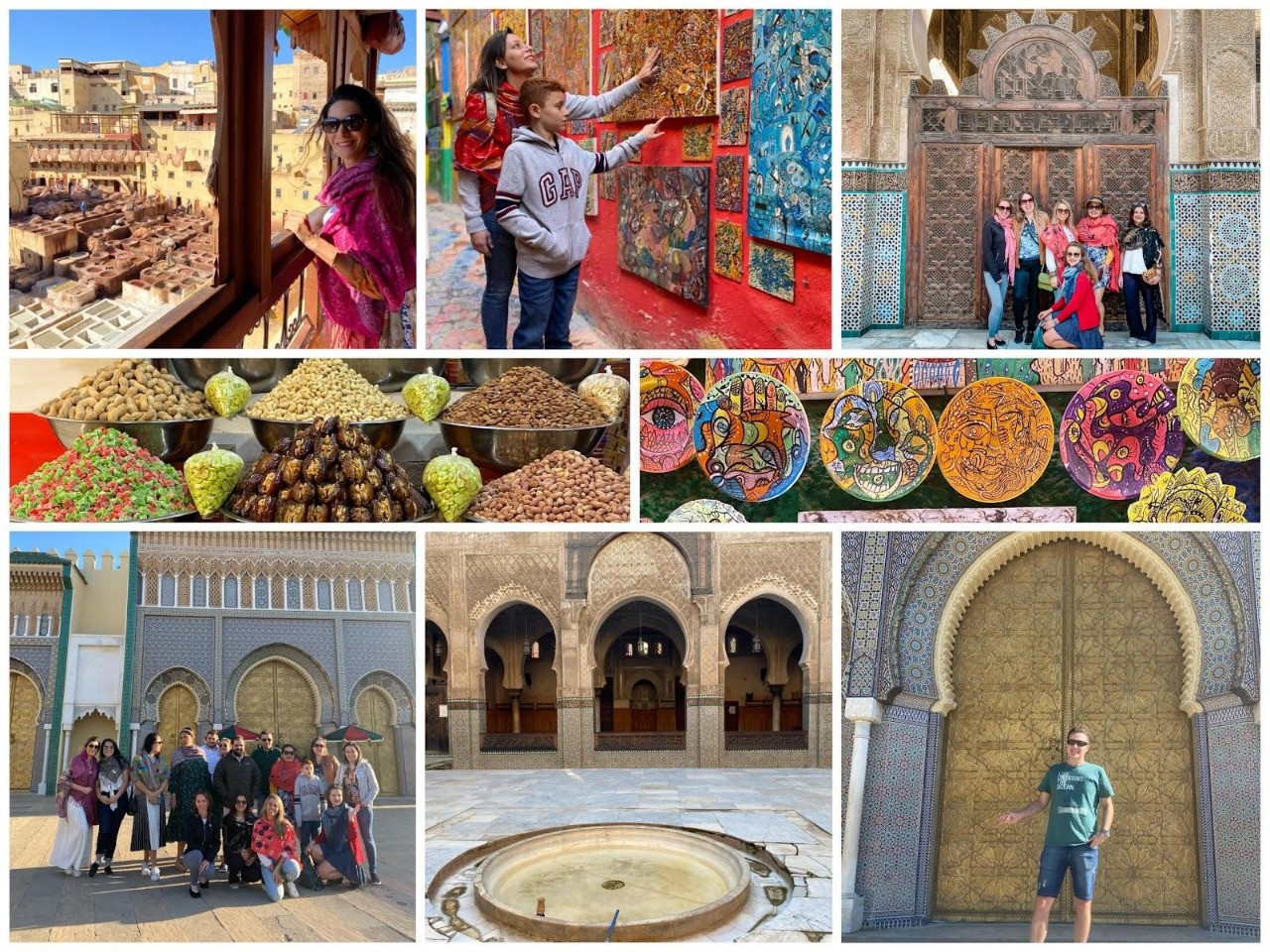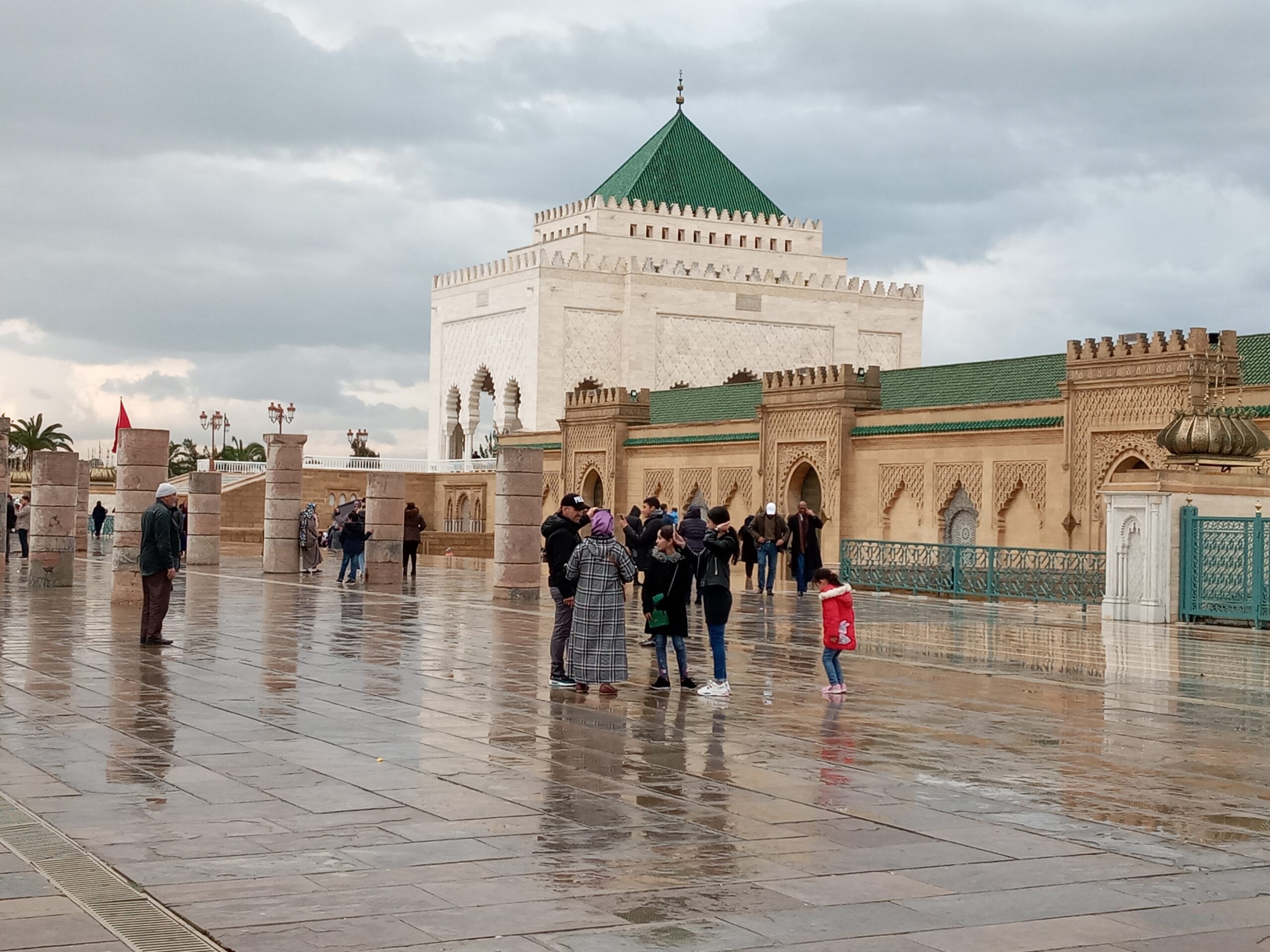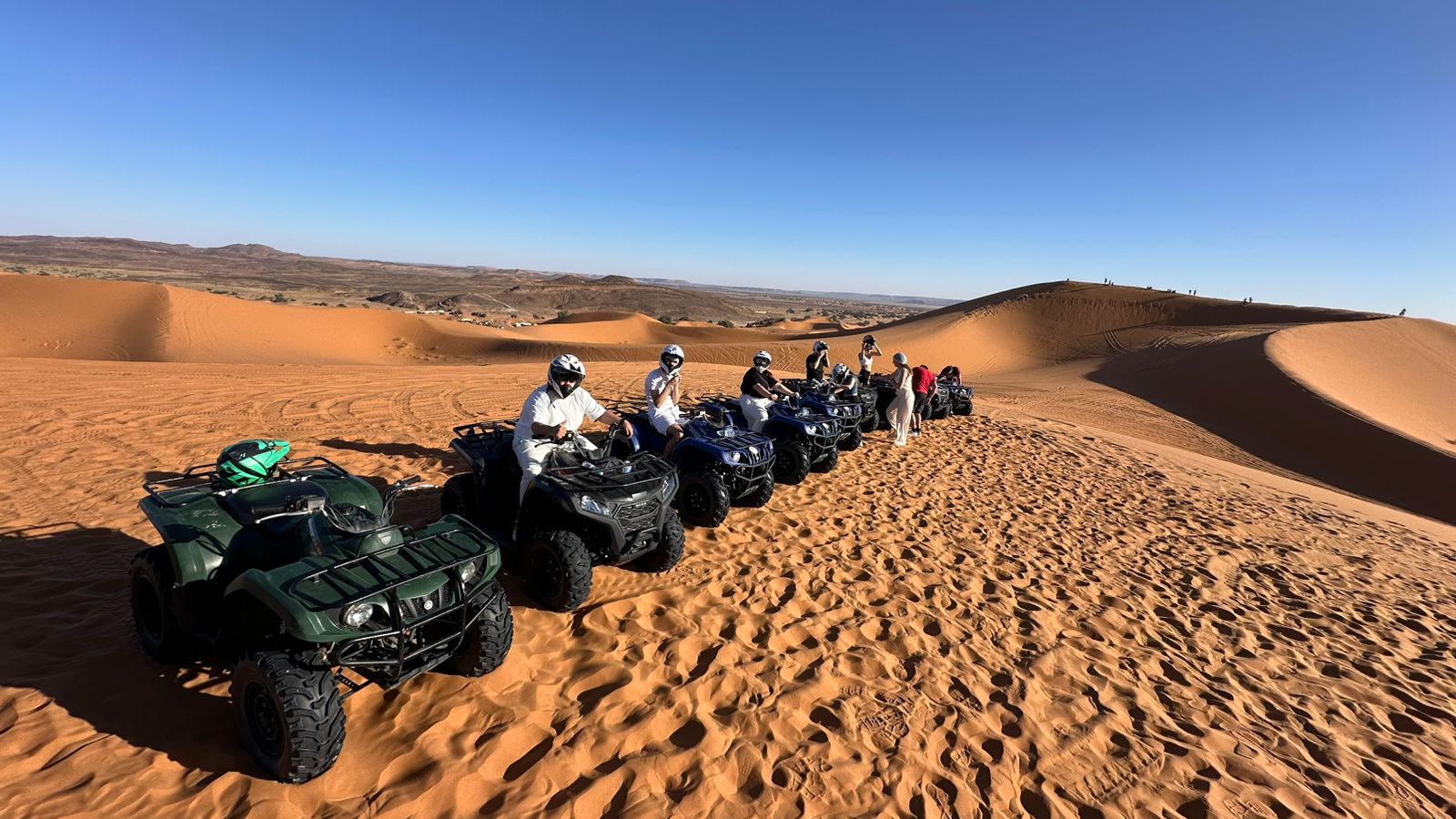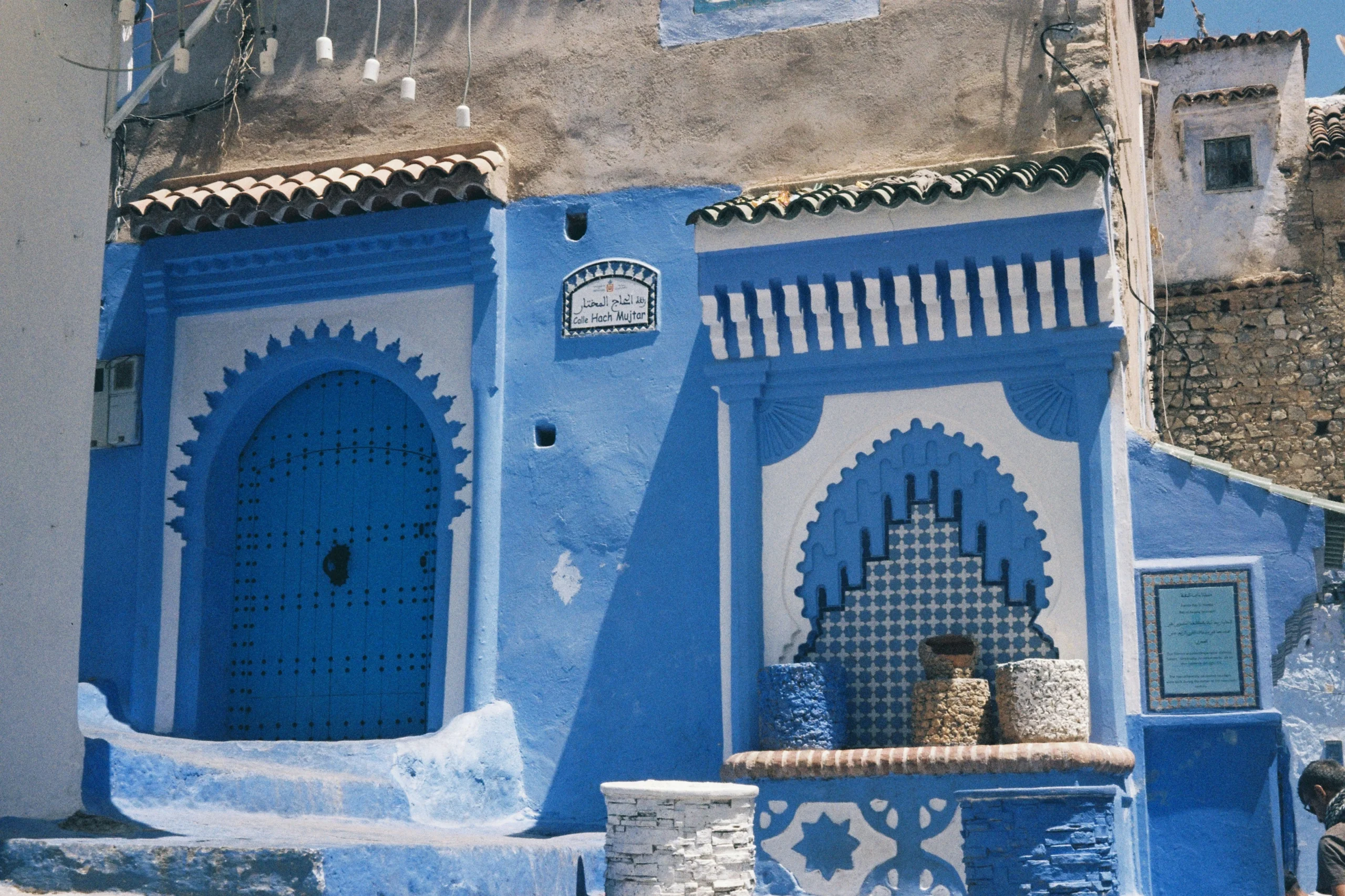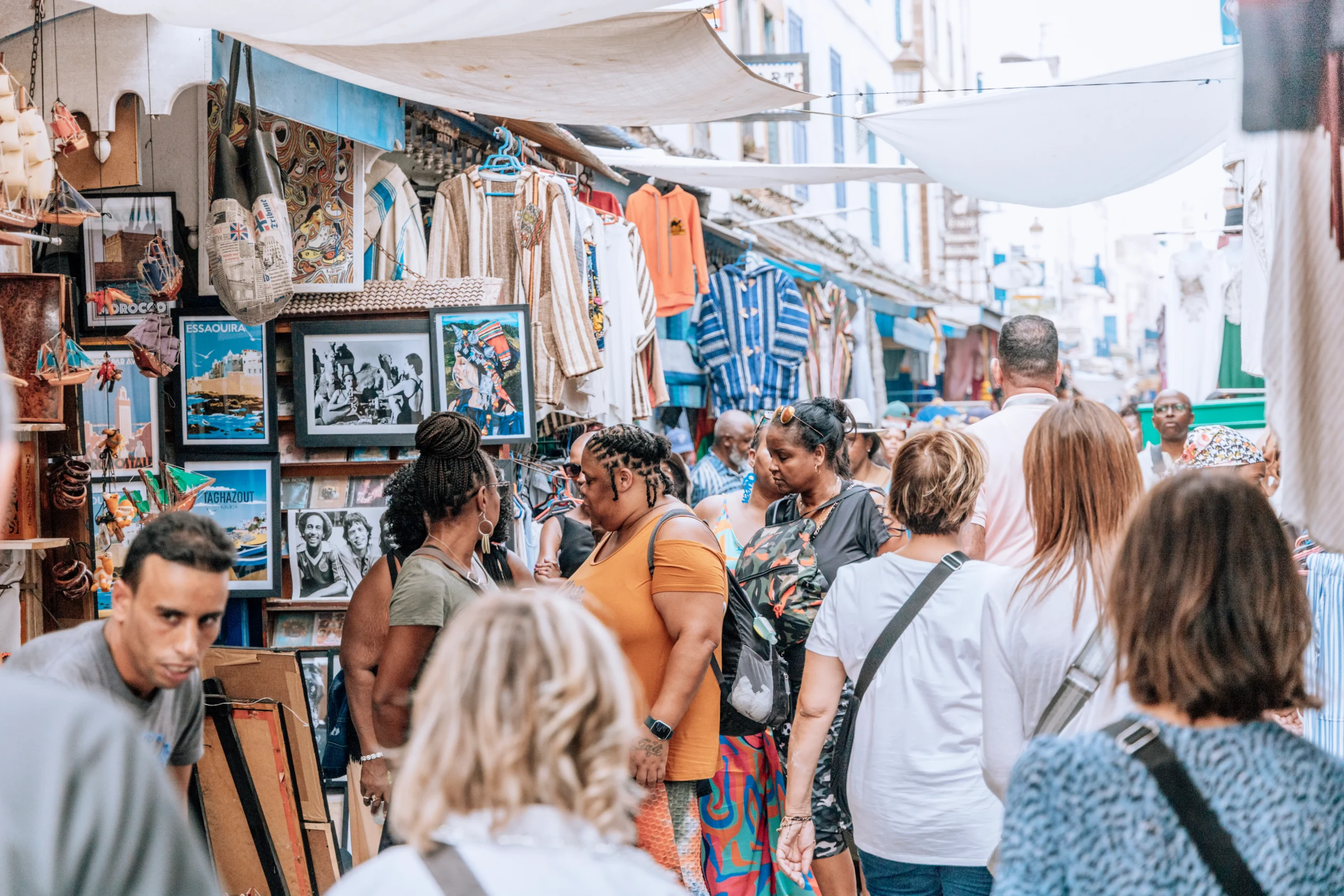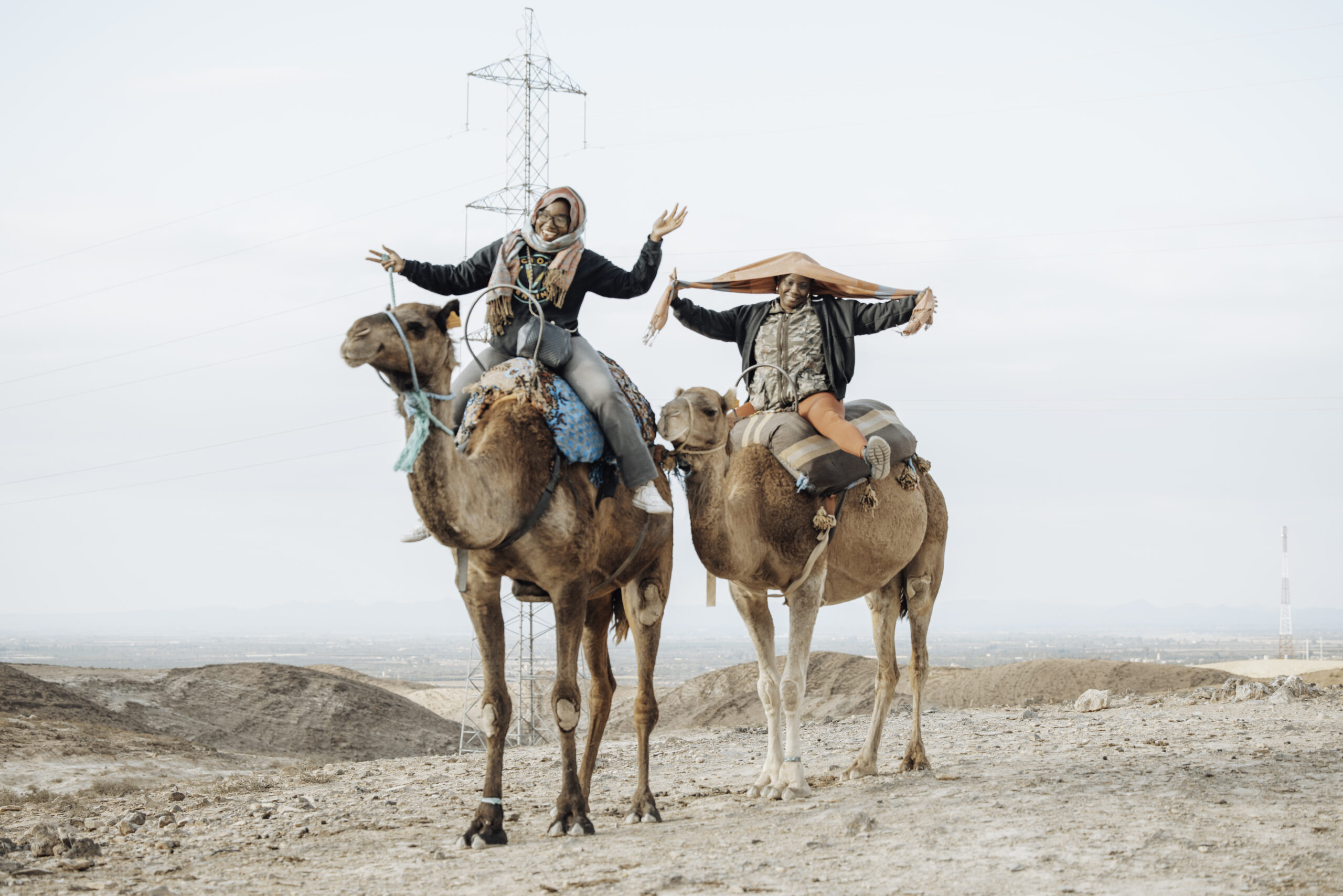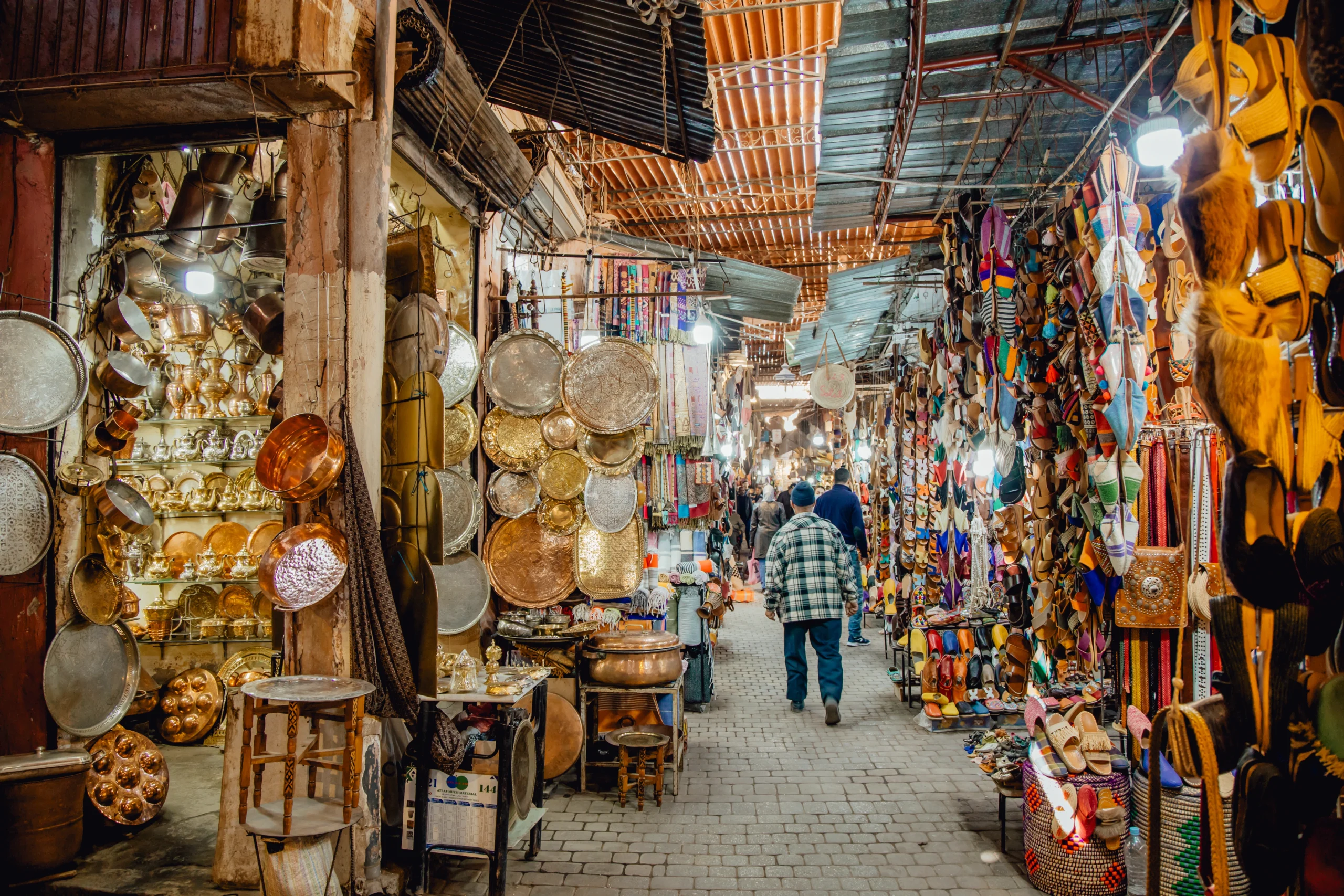Morocco travel: the best places to travel in Morocco
If you’re looking to explore Morocco in-depth, the 10-day Morocco tour is the perfect option for you. This tour covers all the country’s highlights, From Casablanca, the economic capital of Morocco to the bustling city of Marrakech via high Atlas, Morocco Sahara Desert, Middle Atlas, Fes, and Chefchaouen in the north. You’ll have the opportunity to explore ancient Medinas, ride camels in the sand dunes, overnight in a luxury desert camp, and haggle for souvenirs in the markets.
And of course, a tour through Morocco would invariably be incomplete without savoring the nation’s renowned culinary delights, such as Tajine, Couscous, Bastila, and Harira. As such, this itinerary ensures an authentic experience in each city visited, complemented by the traditional mint tea, serving as a hallmark of Moroccan hospitality.
The 10-day Morocco tour allows for arrive and departures from various Moroccan cities, including Casablanca, Rabat, Marrakech, Fes, ensuring convenience and variety of chooses and ease of access and departure to/from Morocco.
Each destination in this tour is carefully selected to present you with the full spectrum of Morocco’s enchanting diversity, from its bustling cities to serene landscapes, each imbued with a rich tapestry of culture and history. We invite you to explore the details, sights, and charms of each city individually.
Morocco travel: the best places to travel in Morocco
1. Casablanca:
Casablanca, also known as Al-Dār al-Bayḍāʾ, or Dar al-Beïda in Arabic, is the largest and most important city in Morocco.
Casablanca is the most popular tourist destination in Morocco due to its abundance of beautiful beaches, parks, and seaside promenades.
Inland from the docks and the harbour is the old city, or medina, the original Arab town. Still enclosed in parts by its original rampart walls, it is a maze of narrow streets and whitewashed brick or stone houses. In a semicircle outside the walls of the medina is the town built by the French. Avenues radiating from Muḥammad V Square are intersected by ring roads that reach to the coast on either side of the harbour. Muḥammad V Square, near the gateway of the old medina, and United Nations Square are the business and administrative centres of the town, where banks, hotels, and large modern shops are located. Farther south, overlooking the gardens of the Park of the Arab League, is the white Cathedral of the Sacré Coeur.
Hassan II Mosque is one of the biggest and most magnificent mosques in the world and is located in a coastal area that was created by building up land along the coast.
Public transportation mostly consists of buses. Both small, “petit,” taxis and larger, “grande,” taxis operate inside the city and the surrounding area, respectively. Casablanca may be reached from other major cities through road network. A train line runs northeast to south. Marrakech in the south and Tangier in the north. As well, There is an international airport in Casablanca: Mohammed V International Airport.
2. Rabat
Rabat, or Ribāṭ in Arabic, is the name of Morocco’s capital city. Located on the Atlantic coast near the entrance of the Wadi Bou Regreg, the city stands opposite Salé as one of Morocco’s four imperial capitals.
Rabat, the capital of Morocco, is a city rich in history and emanates a feeling of calm authority despite its relatively calm grandeur when contrasted to the hustle and appeal of Casablanca and Marrakesh. In visiting this city, you follow in the royal and imperial footprints of kings and sultans.
Rabat is a lovely city with an abundance of historical and cultural monuments that visitors should not miss. Here are some of the best places to visit in Rabat:
Kasbah of the Udayas: Located on a hill overlooking the Bou Regreg River, this medieval stronghold provides breathtaking views of the surrounding city. The Kasbah is a typical example of Moroccan architecture, with its winding alleyways and blue and white painted buildings.
Hassan Tower: This 12th-century minaret is part of an incomplete mosque that was intended to be the largest in the world. The tower is 44 meters tall and features intricate carvings and decorations.
Chellah Necropolis: This historic site is located in the heart of Rabat and features the ruins of a Roman city and a medieval Islamic necropolis. It also has a beautiful garden and a pond that is home to dozens of storks.
Mausoleum of Mohammed V: This beautiful mausoleum is the final resting place of King Mohammed V and his two sons. It features traditional Moroccan architecture, marble floors, and intricate decorations.
Rabat Medina: This historic neighborhood is located in the heart of Rabat and features traditional souks, markets, and shops selling a variety of goods such as spices, leather goods, and textiles.
Although there are some sketchy neighborhoods, Rabat is a mostly safe and friendly destination. However, it is wise to be cautious in busy places and to avoid late-night strolls in new neighborhoods.
3. Chefchaouen (the blue-painted dream)
Located in northern Morocco, not far from the Mediterranean Sea, lies the beautiful blue town of Chefchaouen. Chefchaouen is strange, quiet, and gorgeous in contrast to the chaos of Marrakech and Fez. When you enter Medina, it will be as if you’ve stepped into a another universe. Everywhere you look, there is picturesque landscape, making this a photographer’s paradise.
Chefchaouen is most pleasant to visit between March and September, when the weather is moderate and the native fruits are plentiful. The fruit is at its peak of ripeness and affordability right now. The most important thing is that the weather is pleasant and ideal for playing.
And while the stunning color is the main reason people go to Chefchaouen, the city offers a lot more:
- Explore the Medina’s complexity of winding streets and stairs.
- Visit the museums.
- Check out the city’s many brightly painted entrances.
- Try some authentic Moroccan cuisine.
- Visit the local markets such as the souks.
- Get together on a roof with a view of the city.
- Take in the sounds of the Prayer Call.
- The sunset is beautiful over the Blue City.
- Meet the welcoming natives!
- Snap some stunning shots around town.
- Chefchaouen, sometimes known as the “Blue City,” has become more popular among tourists due in no little part to the abundance of exciting activities available to its visitors.
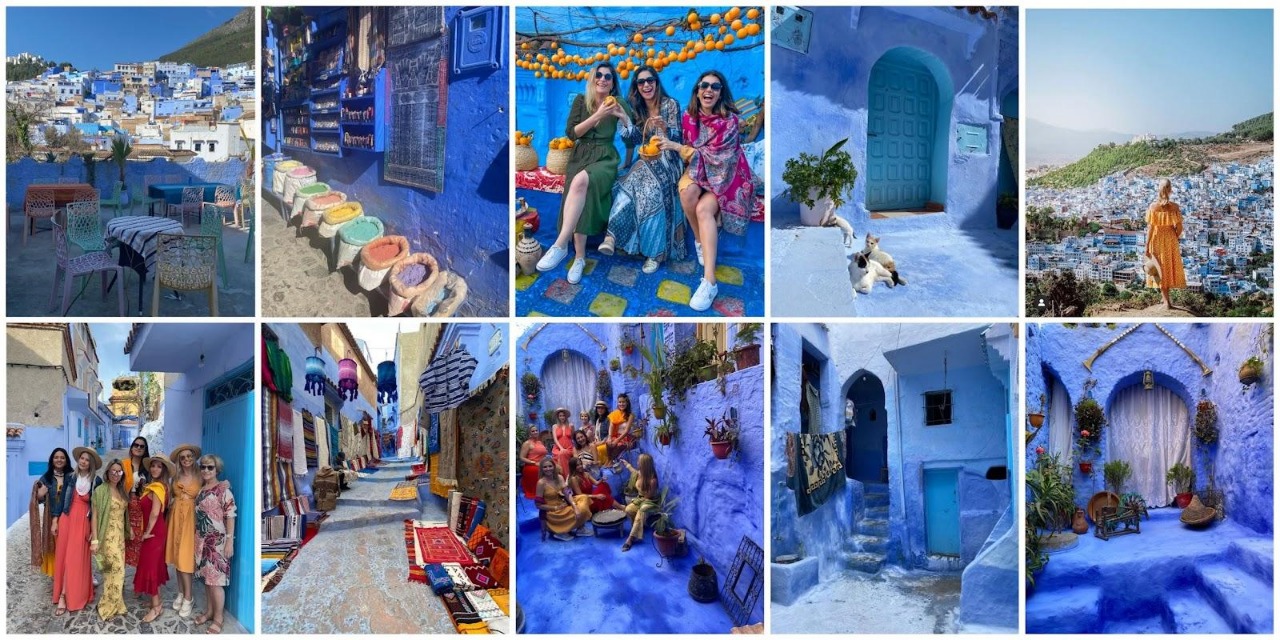
4. Volubilis and Fes - Echoes of the Ancient
- Volubilis
Near Meknes, in between Fes and Rabat, is found the partially excavated Roman city of Volubilis. A Phoenician (and subsequently Carthaginian) colony, it was established in a prosperous agricultural region beginning in the 3rd century BC.
It is because Volubilis is “an exceptionally well preserved example of a large Roman colonial town on the fringes of the Empire” that it has been designated as a UNESCO World Heritage Site.
Volubilis is home to the ruins of a Roman municipium that was constructed on a strategic location at the base of Jebel Zerhoun. The 42-hectare site is very significant because it shows urbanization and Romanization on the outskirts of the Roman Empire and provides a striking visual representation of the interaction between Roman and indigenous societies.
- Fes
Fes is a city rich in history and culture, and it provides visitors with a wide variety of activities to choose from. Fes, Morocco, is a popular tourist destination due to its old Medina and bustling marketplaces. This paragraph delves into the fascinating realm of Fes, uncovering the city’s undiscovered treasures, cultural history, and life-changing experiences that await the intrepid traveler.
Fes is like stepping into a time machine that takes you back to a vast and mysterious age. Fes’s beautiful architecture, lively markets, and friendly residents make for a wonderful travel experience.
The following are some of the popular tourist destinations in Fes:
Al Quaraouiyine University: Both UNESCO and Guinness World Records recognize it as the world’s oldest educational institution. It was created in 859 by Fatima Al Fihri and became one of the greatest spiritual educational institution in the Islamic world.
Tannaries: It’s in Fez El Bali, and it’s the biggest of Fez’s three tanneries. It was constructed in the 11th century and is now a popular tourist destination in Fez.
The Madrasa Bou Inania: It was established in the years 1351–1356 and is widely regarded as one of the finest exemplars of Mirinid design. It rose to popularity as a major place of worship in Fez and across Morocco.
The Royal Palace: The Alaouite Sultan resides in this royal palace. It covers 80 acres and is off-limits to the general public. The beautiful entrance must please visitors, since it draws many of them with its depictions of brass, gorgeous Zelij, and carved cedar wood.
While in Fes, you may also check out other attractions. Seffarin place, where artisans create stunning copper plates and other wares. The factory where stunning ceramics are produced is open for tours as well.

5. Merzouga
Merzouga is a nice place to visit in the Sahara Desert. Try these recommendations:
Camel trekking: is a popular activity for visitors to the Sahara. Enjoy the calm and tranquility of the desert on a camel ride across the Sahara sand dunes.
Sandboarding: Sand boarding, which is very much like snowboarding but done on the sand dunes of the Sahara, is another option. You may rent sand boards from stores in the area and participate in this exciting and entertaining sport.
Desert Camping: A night spent in a desert tent is one that can’t be replicated. Enjoy a great Moroccan meal under a gorgeous night sky while staying in a traditional Berber tent.
Sunrise/Sunset Watching: Both sunrise and sunset in the Sahara are spectacular. You can see the sunrise or sunset across the seemingly endless sand dunes by climbing to the top of one.
4×4 Excursions:: Desert 4×4 tours are another option for seeing the Sahara’s outlying regions and hidden gems.
In conclusion, the Merzouga Sahara desert is full with exciting opportunities, each of which will leave you with a story to tell and memories to last a lifetime.
6. Kasbah Ait Benhaddou
Kasbah Ait Benhaddou: Located near Ouarzazate, Ait Benhaddou, this The UNESCO World Heritage Site, is a wonderful example of southern Moroccan architecture. This pre-Saharan ksar is an excellent example of the traditional mud-brick building techniques that were common in the area. It has been an important resting place for caravans traveling across the Atlas Mountains to Marrakesh and beyond since the 17th century, when it first appeared on maps.
The location’s impeccable preservation of its original Moroccan architecture has made it a popular choice for the production of countless major motion pictures and television shows. It’s been seen in blockbuster movies like “Lawrence of Arabia,” “The Mummy,” and “Gladiator,” and even “Game of Thrones,” the critically acclaimed HBO series. This feature has added a contemporary appeal to Ait Benhaddou, attracting film lovers from all over the globe.
Ait Benhaddou offers a glimpse into the past with its traditional earthen structures and intricate designs. Visitors can enjoy panoramic views, explore local craftsmanship, and relax in quaint cafes. This UNESCO World Heritage Site beautifully preserves Morocco’s heritage, blending historical allure with modern charm.
7. Marrakech
Central Morocco’s most important city is Marrakech. It is the first of four imperial cities in Morocco. In 1985, UNESCO included the Medina, the city’s historic center, on its list of World Heritage Sites.
The country was named after the city of Marrakech, which served as its capital for many years. In the middle of the eleventh century, Ysuf ibn Tshufn constructed it.
In Marrakech, the Medina is also known as the “red city” because of the battered clay houses and walls that were constructed during the Almohad era. Jamaa el-Fna square is the heart of the Medina and home to a bustling market.
The 1,000-acre (405-hectare) walled Agdal gardens and the Menara olive grove are two of Marrakech’s most well-known parks. The city’s gardens still rely on an irrigation system put in place by the Almoravids and continues in use today. The city is a commercial hub for the High Atlas Mountains and Sahara commerce, and a popular destination for tourists and winter sports enthusiasts because of its proximity to an international airport.
- Visit the Medina: Discover the heart of Marrakech in the ancient Medina, a UNESCO World Heritage Site. Navigate its alleys, visit historic landmarks like the Koutoubia Mosque and Bahia Palace, and enjoy the lively souks.
- Explore Jardin Majorelle: Find tranquility in the Jardin Majorelle, created by Jacques Majorelle and restored by Yves Saint Laurent. This peaceful garden features exotic plants and striking blue architecture.
- Experience Djemaa El-Fna: At sunset, head to Djemaa El-Fna. Enjoy a vibrant mix of musicians, dancers, and street food, including mint tea and orange juice, amidst the square’s electric atmosphere.
- Relax in a Hammam: Embrace the luxury of a traditional hammam for a relaxing and cultural experience. Enjoy steam baths and scrubs with Moroccan black soap.
- Day Trip to the Atlas Mountains: Venture outside the city to the Atlas Mountains. Explore scenic trails, visit Berber villages, and savor traditional Berber cuisine in this serene natural setting.
Explore more blog posts: here
Explore more about our tours: here

